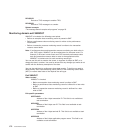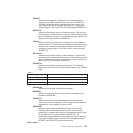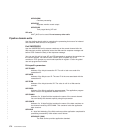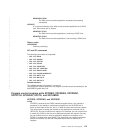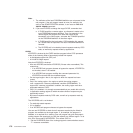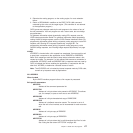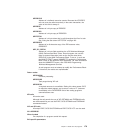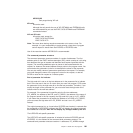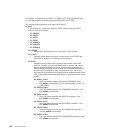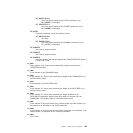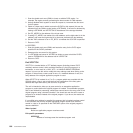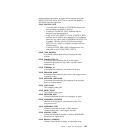UEPCLPS
Address of the command parameter list.
UEPPCTOK
Address of a 4-byte token passed from XPCREQ. This allows
XPCREQ to, for example, pass a work area to XPCREQC.
UEPRCODE
Address of a 6-byte hexadecimal copy of EIBRCODE.
UEPRECUR
Address of a halfword recursion counter. The counter is set to 0
when the exit is first invoked, and is incremented for each recursive
call.
UEPRESP
Address of a 4-byte copy of EIBRESP.
UEPRESP2
Address of a 4-byte copy of EIBRESP2.
UEPTSTOK
Address of a 4-byte token that is valid throughout the life of a task.
See “Using the task token UEPTSTOK” on page 185.
UEPRSRCE
Address of an 8-character copy of the EIB resource value,
EIBRSRCE.
UEP_PC_REMOTE_SYSTEM
If the request is to be sent to a remote region, is the address of an
area containing the 4-byte name of the remote region. (The remote
region may have been specified by, for example, the SYSID option
of the EXEC CICS LINK command, function shipping, work-load
management, or the REMOTESYSTEM option of the PROGRAM
definition.)
If the request is to be executed on the local region, this parameter
is the address of a 4-byte area containing blanks.
UEP_PC_REMOTE_NAME
If the program is to be executed in a remote system, is the address
of an area containing the name of the program, as it is known in
the remote system.
UEP_PC_PBTOK
Address of a 4-byte field containing the z/OS Workload Manager
(WLM) Performance Block Token. An exit program can use this
token to access information (such as the service class token,
SERVCLS) in the WLM Performance Block. To do so, it must use
the WLM EXTRACT macro, IWMMEXTR, passing the Performance
Block Token as the MONTKN input parameter. For more information
about the IWMMEXTR macro, see z/OS MVS Programming:
Workload Management Services.
An exit program must not attempt to modify the Performance Block:
if it does so, the results are unpredictable.
Return codes
UERCNORM
Continue processing.
180 Customization Guide



